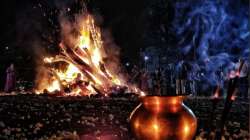What is Holashtak: Know Date, Time, why we shouldn't do any auspicious work during Holashtak
As per Hindu mythology, it is believed that a few days before Holi many auspicious ceremonies including housewarming, marriage, mundan rites etc. should not be performed. This period before Holi is considered inauspicious and is called Holashtak.

The festival of colors, Holi is just around the corner. This year Holi will be celebrated on March 18 (Friday). As per Hindu mythology, it is believed that a few days before Holi many auspicious ceremonies including housewarming, marriage, mundan rites etc. should not be performed. This 8 day period before the festival of Holi is considered inauspicious and is called Holashtak. Holashtak falls on Ashtami tithi of Phalguna month, Shukla Paksha, and continues till Purnima, that is, Holika Dahan. The phase of Holashtak this year will start from March 10 and will continue till March 17th.
What is Holashtak?
During Holashtak the nature of all the planets is fiery. Moon on Ashtami, Sun on Navami, Saturn on Dashami, Venus on Ekadashi, Guru on Dwadashi, Mercury on Trayodashi, Mars on Chaturdashi and Rahu on Purnima are raging. Due to this reason these eight days are called Holashtak. Business, sale of a vehicle, housewarming, foundation worship, marriage etc. should not be done in this time period.
The mythological reason behind Holashtak
There's a belief that Kamadeva dissolved the penance of Lord Shiva. Due to this Lord Shiva burnt Kamdev to ashes by opening his third eye on Ashtami tithi of Phalguna. In order to revive her husband, Kamadeva's wife Rati worshiped Shiva, due to which the Lord, after being pleased, accepted Rati's words and told the remedy. After which its happiness was celebrated in the general public and the festival of Holi was celebrated.
The scientific reason behind Holashtak
According to scientific reasons, negative energy enters nature from Ashtami tithi of Phalguna Shukla Paksha. Therefore, home entry or any auspicious work is often not done during this period.